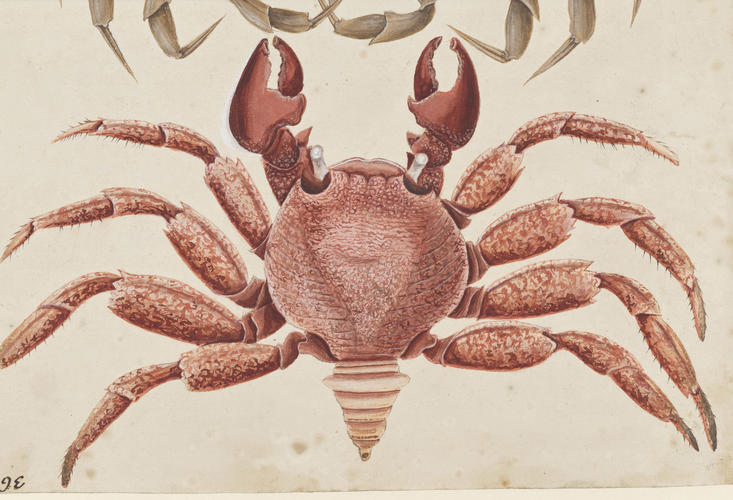-
1 of 253523 objects
The Red Mottled Rock-Crab and the Rough-Shell'd Crab c.1722-6
Watercolour and gouache heightened with gum arabic, over pen and brown ink and graphite; some corrections in white | 37.2 x 26.9 cm (sheet of paper) | RCIN 925982
-
A watercolour of a sally lightfoot crab (above, Grapsus grapsus (Linnaeus)) and a flame box crab (below, Clappa flammea (J.F.W. Herbst). The drawing shows two crabs, both seen from above.
Mark Catesby was born in Suffolk and was interested in natural history from an early age. In 1712, he travelled to the east coast of America with his sister Elizabeth, who had married a doctor who practised in Williamsburg, Virginia. Catesby spent seven years in Virginia collecting specimens and seeds for London buyers before returning to Britain. In London his drawings of birds and plants met with praise and a group of benefactors paid for his travel to Carolina in 1722. There, he made numerous drawings of the flora and fauna, working hard to ensure that his depictions were as helpful for an understanding of their subjects as possible. On his return to Britain, his drawings were reproduced in The Natural History of Carolina, Florida and the Bahama Islands, which appeared in a series of volumes between 1729 and 1747. The first volume was dedicated to Queen Caroline, the second to Augusta, Princess of Wales. The original drawings from the volumes, which had been in the possession of Catesby’s widow until her death, were purchased by George III from the London bookseller Thomas Cadell in 1768.
Catesby’s treatment of the textures and colouring of the shells here is very detailed. Of the lower crab on this sheet, the flame box crab, he wrote ‘as the Structure of the Fish is so much better understood by the Figure of it than by the most tedious Description, I shall only observe that the whole shell is covered with innumerable little Tubercles, resembling Shagrine [shark skin]: the Colour of it is brown variously stained with purple.’
The watercolour was used as the basis for plate 36 in the second volume of the Natural History ('The Red Mottled Rock-Crab' and 'The Rouhg-Shell'd Crab').
For identification of the species depicted see James L. Reveal, 'Identification of the plants and animals illustrated by Mark Catesby for his Natural History of Carolina, Florida, and the Bahama Islands' in Phytoneuron 2013 and revised online version.Provenance
Thomas Cadell; from whom bought by George III, 1768
-
Creator(s)
Acquirer(s)
-
Medium and techniques
Watercolour and gouache heightened with gum arabic, over pen and brown ink and graphite; some corrections in white
Measurements
37.2 x 26.9 cm (sheet of paper)
Other number(s)
RL 25982Alternative title(s)
Pagurus Maculatus; Cancer Chelis Crassissimis

